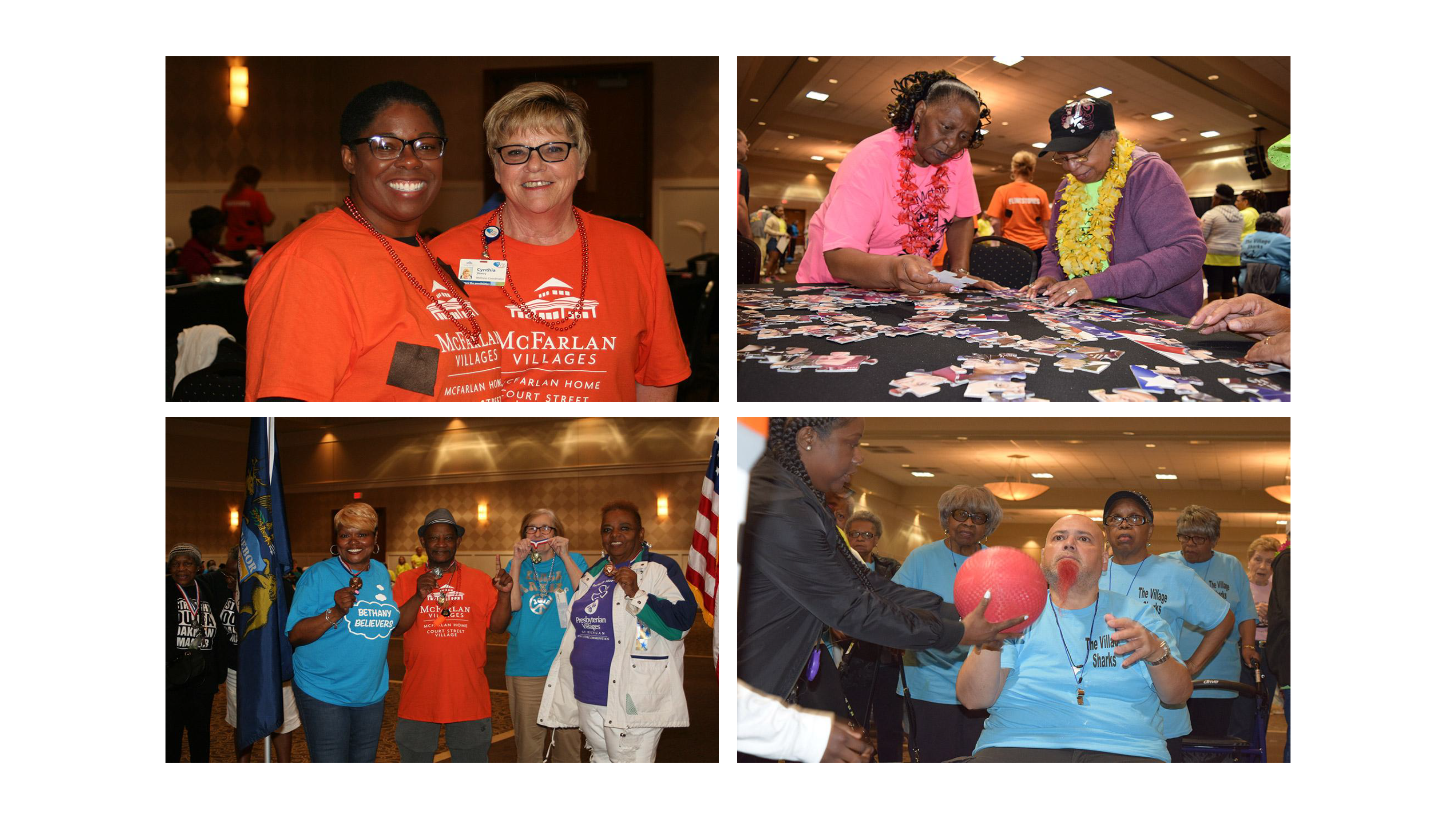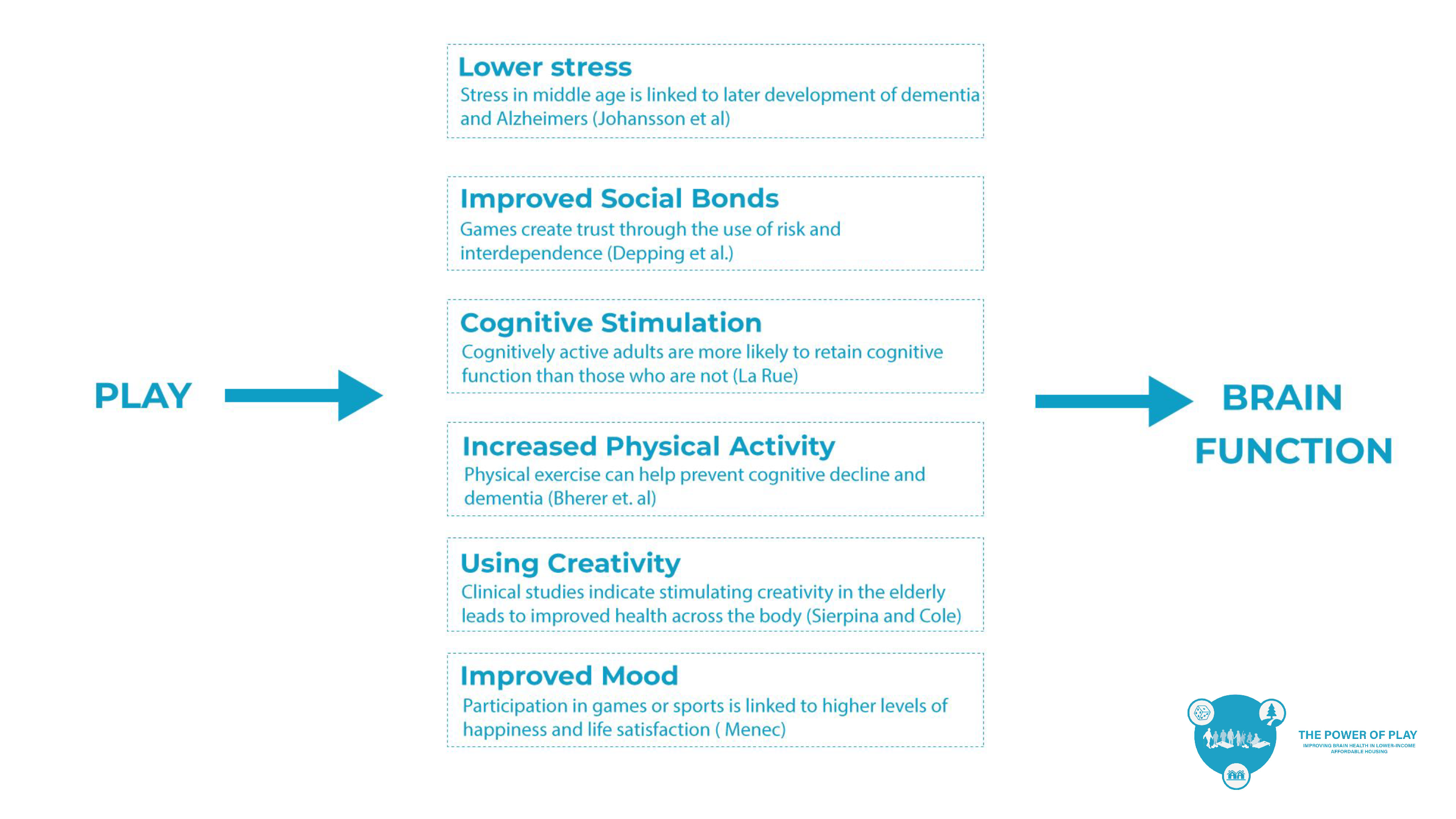︎ Power of Play: Improving Brain Health In Lower-Income Affordable Housing
How can we create digital and physical spaces for playto help seniors improve their brain health and sense of belonging in their communities?
By Maya Fraser ︎ , Sophie Jackson ︎ , Zoe Elliott ︎

Why
An estimated 43% of adults over 60 experience loneliness (NASEM). Loneliness has important health consequences, including increased risks of death (increase of 20%) and cognitive decline (increase of 60%) (Ristau). Older adults experiencing loneliness are at a much greater risk of death and severe disease than those who frequently interact with others. This includes an 50% increase in the risk of developing dementia (NASEM). More than one third of older adults in the United States report feeling lonely, and the COVID-19 pandemic has only exacerbated this trend (NASEM). As a result, many adults in the United States are at an increased risk of poor brain health.
To better understand solutions to this challenge, we used Presbyterian Villages of Michigan as a prototype test case. PVM is a faith-based, non-profit network of senior-living communities that provides low-income seniors with the opportunity for independent living, assisted-living, or memory care, depending on the community.
Hypothesis
If we create year round opportunities for play for seniors in the Presbyterian Village Communities, then there will be increased social engagement which will result in a higher sense of belonging and overall better brain health.

Residents of the Presbyterian Villages of Michigan engaging in play / Presbyterian Villages of Michigan 2021
How
While observing residents of Woodbridge and St. Martha's Presbyterian Villages of Michigan, we observed a lack of opportunities for social engagement that were applicable throughout the year. Several of the indoor spaces were underutilized by the residents, due to the small size of rooms and lack of windows. Residents and administration also cited the need for activity set-up in these spaces as a challenge. Administration specifically noted that when events are held, much of the set up and organization fell to staff to do which is quite challenging if needed to do frequently.
To address this gap and improve the brain health of residents, we decided to create digitial and physical spaces specifically for play that will connect different living communities within the Presbyterian Village Network. We decided to focus on play because it improves brain health through many different pathways. The social aspect of play combats loneliness, leading to lowered stress and improved social bonds. Engaging in play also strengthens cognitive function, increases physical activity, stimulates creativity, and improves mood.

Links between play and brain health
Methodology
To understand the challenges facing residents of the Presbyterian Villages and their potential solutions, we used several strategies. First, we visited the Village of St. Martha’s and Woodbridge Manor to observe existing facilities and talk with administrators and residents. We also conducted a literature review of the relationship between brain health and play. Finally, we met with experts to gain domain-specific feedback.

The “Fun Bus”
Design To Outcomes
Now
The Victor's Cup is an annual, widely-anticipated competition event that involves communities across the Presbyterian Villages of Michigan network. An impactful intervention we could implement right now Presbyterian Villages is a more frequent (monthly) Victor's Cup with online leaderboards which will help connect the Village's social network through digital space. Specfically, we would develop a systematic policy around games to create a Michigan-wide community of gaming and competition. From our observations and conversations with residents, it is a fun and popular event. By making the Victor's Cup competition and gaming practice once a month, we can bring this excitement and physical activity more often.
Each month we will provide each of the PVM villages with a game, giving the residents an opportunity to score as many points as they can. An online leaderboard will display the top scores across the different villages, instigating a sense of community and competition between residents in the same village and across the villages). The variety in games will provide opportunities for residents of varying physical and cognitive abilities to participate.
Near

Fun Bus in warm weather

Fun Bus in colder weather
The intervention we plan for the near future and with grant funding would be a travelling fun/ game bus that would visit each village for a limited amount of time. Because the bus only comes occasionally, its arrival would mark a special occasion that could get residents excited.
The fun bus is a trailer that is attachable and detachable from a van or truck and is able to occupy either the greenspace or parking lot. It can store a collection of fun games and activities which can be set up upon arrival. To increase occupiable space, the doors open out with additional tent material. Metal poles hold the roof in place, and in winter additional siding can slot into the metal poles to create a tent like structure, allowing for thermal comfort and weather protection.
The flexible programming of the bus means that the games and activities could change across the year, or as needs change. It could also engage with a wider audience, including the families of residents, or the wider community.
Far

Our far intervention will utilize both the physical interior existing spaces and digital space through an app called PVM CONNECT. This would widen our design continuum scale scope to include product and interiors.
PVM CONNECT is an application that can be downloaded onto a tablet or computer and acts as an online leaderboard and tracking system that can be used to measure inter-village competition. The app provides an easy to use score input system that is easy for residents to use. PVM CONNECT is able to track usage and participation through the amount of information put into the scheme. It naturally translates the input scores into leaderboards and acknowledgements that are presented to the competitors on the app.
Measuring Impact
We plan to measure these outcomes now by observing the frequency of participation with the activities and use of the space. Additionally, we will conduct surveys asking residents about their sense of belonging and engagement in the community. In the future, with more funding, we could measure individual outcomes through biometric testing.
So What
Residents of the Presbyterian Villages of Michigan currently lack opportunities to engage in play and social activity. Our intervention offers a cost-effective way to help seniors stay healthy and have a strong sense of belonging. By implementing this intervention, the Presbyterian Villages of Michigan would be able to keep their independent living residents independent for longer.
︎︎︎Link to 2 Pages Research Paper
︎
Works Cited
1. Bherer, L., Erickson, K. I., & Liu-Ambrose, T. (2013). A Review of the Effects of Physical Activity and Exercise on Cognitive and Brain Functions in Older Adults. Journal of Aging Research, 2013, e657508. https://doi.org/10.1155/2013/657508
2. Blume, C., Garbazza, C., & Spitschan, M. (2019). Effects of light on human circadian rhythms, sleep and mood. Somnologie, 23(3), 147–156. https://doi.org/10.1007/s11818-019-00215-x
3. Calkins, M. P. (2020). Designing Gardens to Attract Activity. IDEAS Institute. https://www.pioneernetwork.net/resources/designing-gardens-to-attract-activity/
4. Depping, A. E., Mandryk, R. L., Johanson, C., Bowey, J. T., & Thomson, S. C. (2016). Trust Me: Social Games are Better than Social Icebreakers at Building Trust. Proceedings of the 2016 Annual Symposium on Computer-Human Interaction in Play, 116–129. https://doi.org/10.1145/2967934.2968097
5. Jimenez, M. P., DeVille, N. V., Elliott, E. G., Schiff, J. E., Wilt, G. E., Hart, J. E., & James, P. (2021). Associations between Nature Exposure and Health: A Review of the Evidence. International Journal of Environmental Research and Public Health, 18(9), 4790. https://doi.org/10.3390/ijerph18094790
6. Johansson, L., Guo, X., Waern, M., Östling, S., Gustafson, D., Bengtsson, C., & Skoog, I. (2010). Midlife psychological stress and risk of dementia: A 35-year longitudinal population study. Brain, 133(8), 2217–2224. https://doi.org/10.1093/brain/awq116
7. La Rue, A. (2010). Healthy Brain Aging: Role of Cognitive Reserve, Cognitive Stimulation, and Cognitive Exercises—ClinicalKey. Clinics in Geriatric Medicine, 26(1), 99–111. https://doi.org/10.1016/j.cger.2009.11.003
8. Menec, V. H. (2003). The Relation Between Everyday Activities and Successful Aging: A 6-Year Longitudinal Study. The Journals of Gerontology: Series B, 58(2), S74–S82. https://doi.org/10.1093/geronb/58.2.S74
9. National Academies of Sciences, Engineering, and Medicine 2020. Social Isolation and Loneliness in Older Adults: Opportunities for the Health Care System. Washington, DC: The National Academies Press.https://doi.org/10.17226/25663.
10. Patterson, Michael C., and Susan Perlstein. “Good for the Heart, Good for the Soul: The Creative Arts and Brain Health in Later Life.” Generations: Journal of the American Society on Aging 35, no. 2 (2011): 27–36. https://www.jstor.org/stable/26555772.
11. Razani, N., Malekinejad, M., & Rutherford, G. W. (2021). Clarification Regarding “Outdoor Transmission of SARS-CoV-2 and Other Respiratory Viruses: A Systematic Review.” The Journal of Infectious Diseases, 224(5), 925–926. https://doi.org/10.1093/infdis/jiab298
12. Ristau, Stephen. “People Do Need People: Social Interaction Boosts Brain Health In Older Age.” Generations: Journal of the American Society on Aging 35, no. 2 (2011): 70–76. https://www.jstor.org/stable/26555777.
13. Rodin, Judith. “Aging and Health: Effects of the Sense of Control.” Science 233, no. 4770 (1986): 1271–76. http://www.jstor.org/stable/1697974.
14. Salthouse, Timothy A. “Mental Exercise and Mental Aging: Evaluating the Validity of the ‘Use It or Lose It’ Hypothesis.” Perspectives on Psychological Science 1, no. 1 (2006): 68–87. http://www.jstor.org/stable/40184198.
15. Sierpina, M., & Cole, T. R. (2004). Stimulating Creativity in All Elders: A Continuum of Interventions. Care Management Journals, 5(3), 175–182. https://doi.org/10.1891/cmaj.2004.5.3.175
16. Wilson, Robert S. “Mental Stimulation and Brain Health: Complex, Challenging Activities Can Support Cognitive Health in Older Adults.” Generations: Journal of the American Society on Aging 35, no. 2 (2011): 58–62. https://www.jstor.org/stable/26555775.